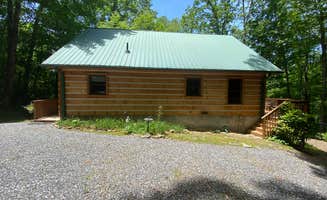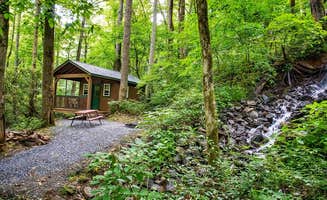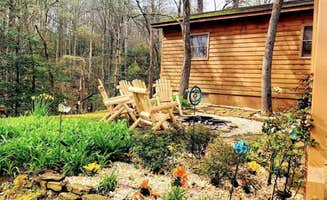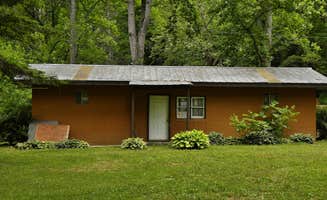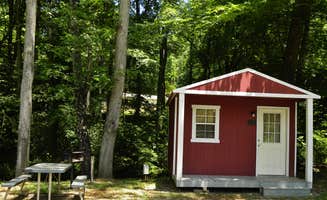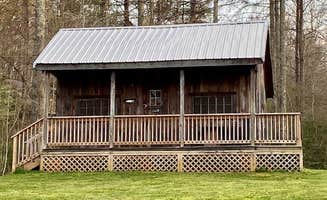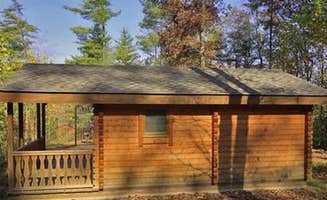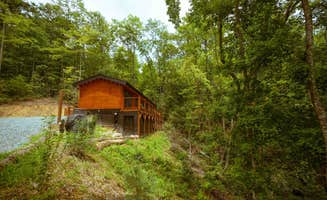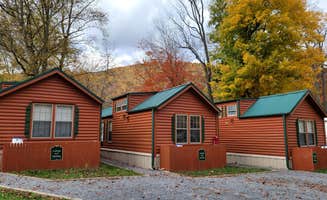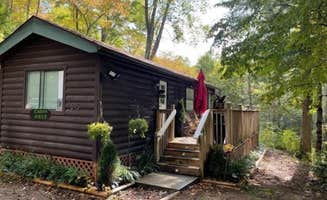Camping cabins near Tuckasegee, North Carolina sit between 2,500 and 3,000 feet elevation in the southern Appalachian Mountains, providing a cooler summer retreat than surrounding lowlands. Temperatures typically average 10-15 degrees cooler than nearby cities, with evening temperatures dropping into the 50s even during summer months. Many rental cabins in this area feature stone fireplaces or wood stoves to combat the mountain chill that can occur even during warmer seasons.
What to do
Trout fishing access: Several campgrounds provide direct creek or river access for fishing enthusiasts. At Indian Creek Campground, campers can fish right from their site. "Our backyard was the mountain and our front yard a creek where we could fish sitting right by our picnic table and fire ring," notes one visitor. The creek is stocked with trout regularly.
Waterfall exploration: Within a 30-minute drive, access numerous waterfall trails ranging from easy to challenging. Gorges State Park Campground offers access to spectacular water features. "Rainbow Falls, Turtle Back Falls and Bust your Ass Falls. The Visitors Center has free parking for RV's and Vans," mentions one camper. The Rainbow Falls trail is a somewhat challenging 4-mile round trip.
Heritage exploration: Visit historic mountain communities and abandoned settlements. One visitor to Elkmont Campground recommends: "One of the more intriguing areas to explore at Elkmont is the Daisy Town ghost town. Follow the signs for additional parking and you'll find yourself at the end of a road lined with assorted cottages and cabins that used to be vacation homes."
What campers like
Creek-side relaxation: Many cabin rentals feature creek-front locations where visitors can wade or simply enjoy the sounds. At Stonebridge RV Resort, "The sites (Premium Creekside) along the creek have plenty of room behind your site to enjoy your site and the creek," explains one reviewer. The flowing water provides natural white noise for sleeping.
Mountain temperatures: The elevation provides relief from summer heat, with cool evenings year-round. "We traveled from Florida to Brevard to hike and camp. It was a 7 hour car trip," shares one Davidson River camper, highlighting how visitors travel significant distances for the cooler mountain climate.
Privacy options: Cabins range from close-quarters resort settings to more secluded forest locations. At Moonshine Creek Campground, "There are cabins and sites up along the hillside which have a view and a little more privacy," notes a camper. Some sites offer more seclusion than others based on terrain.
What you should know
Reservation requirements: Peak season (May-October) requires advance planning, sometimes 3-6 months ahead. "Book your trip a few months in advance, get a spot on the water," recommends one camper about Devils Fork State Park Campground. Holiday weekends often book 6+ months in advance.
Limited connectivity: Cell service varies dramatically across the region, with many cabin areas having spotty coverage. A visitor to Indian Creek notes: "Caveat: NO ATT service and Wi-Fi spotty and slow except when in pavilion. If connectivity is important (and it legitimately can be), this might not be the place for you."
Weather preparedness: Mountain weather can change rapidly, with afternoon thunderstorms common in summer. "It had rained the day we arrived and evidently the past few days because the camp was very muddy," reports one Cherokee-Great Smokies KOA visitor. Always pack rain gear regardless of forecast.
Tips for camping with families
Activity options: Look for campgrounds with dedicated recreation areas for different age groups. The Great Smokies KOA offers "bike rentals, shuttle tours to the mountains, fishing, giant checkers and game boards, a clubhouse area, children's activities and both wifi and cable."
Creek safety: Mountain streams run cold year-round and can rise quickly after rain. At Indian Creek Campground, "The creek/river that runs through is amazing with most campsites sitting along one of the two creeks," but parents should supervise children near water at all times.
Accommodation sizing: Confirm cabin sleeping arrangements when booking. "We stayed in a camping cabin which had a full bed and sleeping loft. The loft is very large," notes a KOA visitor, but cabin configurations vary widely between properties.
Tips from RVers
Site spacing considerations: Many established campgrounds have tight site spacing by design. At The Great Outdoors RV Resort, "Sites are fine (gravel, level, full hookups, spacious, fire ring/firewood on request, picnic table)" but another notes "sites were really close."
Mountain road challenges: RVs face steep grades on mountain roads leading to many campgrounds. One Gorges State Park visitor warns: "The last 10 miles out of Brevard were curvy and had some grades. And the last 2 miles into the campground had I would guess a couple of 10% grades both up and down."
Seasonal weather impacts: Spring brings muddy conditions that affect RV sites more than cabins. "Well it had rained the day we arrived and evidently the past few days because the camp was very muddy. The first site they tried to put us at was all grass and mud. No pavement or gravel," reports a Cherokee KOA visitor.


